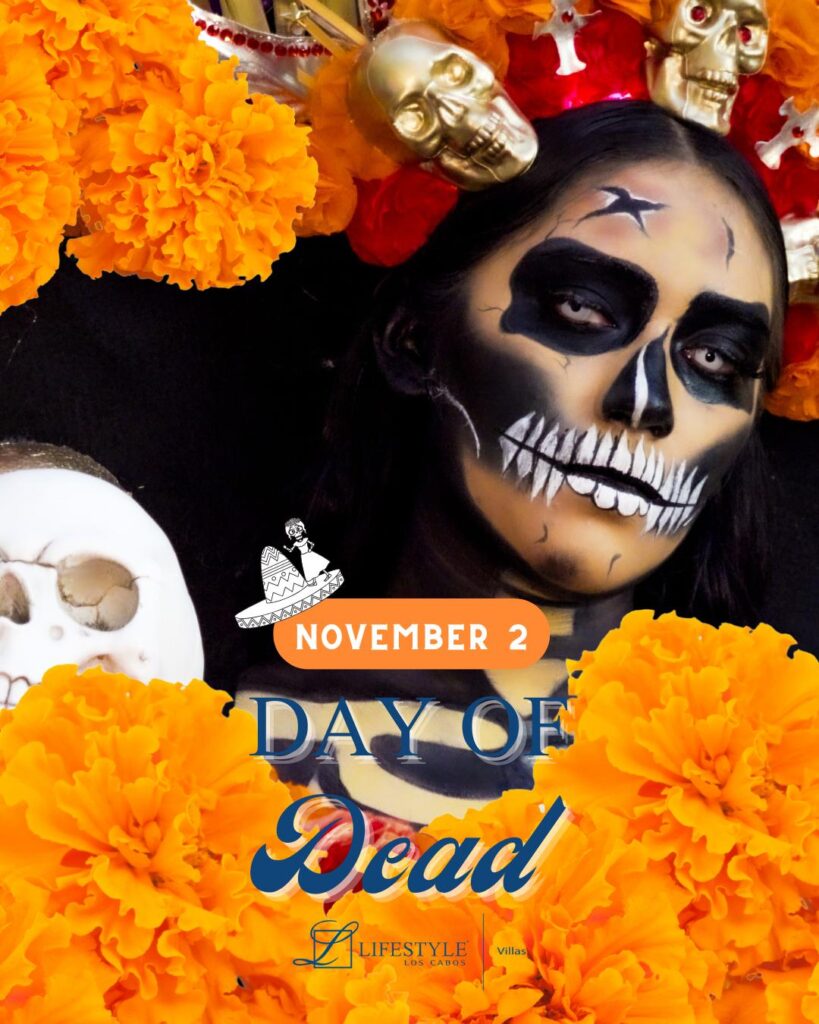DAY OF THE DEAD
The Day of the Dead is one of those holidays that you have to experience at least once in your life. For those visiting Mexico who aren’t familiar with what this celebration means to Mexicans, we want to share what this cultural tradition means to these lands.
Mexico offers a unique perspective on death.
Día de los Muertos – Day of the Dead transforms Mexican cities into vibrant celebrations filled with altars, ofrendas, and elegantly dressed catrinas. Each region brings its own unique traditions, yet all are united by a shared purpose: honoring and remembering loved ones. This captivating holiday, one of the oldest in Mexico with over 500 years of history, blends pre-Hispanic culture with spiritual rituals that celebrate life after death. During Día de los Muertos – Day of the Dead, it is believed that souls return to visit their families, share meals, and relive cherished memories. Marigold flowers light the path, incense like copal fills the air, and diverse offerings ensure the departed are lovingly remembered.
For these cultures, death was not the end, but rather part of a larger cycle. After someone’s death, their body was wrapped in a mat, and a celebration was held to guide them on their way to Mictlán. This perspective on death invites us to reflect on the meaning of life and how we choose to live it.
After the arrival of the Spanish, indigenous culture began to merge with Catholic traditions. New elements were added, such as candles, bread of the dead (made with finer flours), Catholic crosses, and some distilled beverages brought from Europe.
Another important symbol during the celebrations, and one that cannot be forgotten due to its great representation both in Mexico and internationally, is the small skulls, representing the Catrinas, created at the end of the 19th century.
During the holidays, the streets are filled with color: there are dances, people paint themselves as Catrinas, cemeteries are visited with musical bands, family members decorate graves festively, and lively parties are held to welcome the spirits of their loved ones.
Altars are usually set up from late October to November 2.
November 1 is All Saints’ Day; according to Catholic tradition, it honors those who died without being saints and children who died young. On November 2, the Faithful Departed (adults) are remembered, along with prayers for those who have not yet entered paradise.
How are altars set up, and what should they include?
Each family personalizes their altars, and the design varies greatly.
It is common to see altars set up in workplaces, schools, and public or private institutions.
While they include many traditional objects, specific items of the deceased are also remembered.
Some of these are:
– Salt and a white tablecloth: these symbolize purity; Salt represents purification, helps prevent decay, and guides the soul.
– Water: represents purity and soothes the spirits after their journey.
– Candles: The flame symbolizes the spirits’ guidance on their return home. Skulls: Made of sugar or chocolate, they represent death and honor pre-Hispanic traditions.
Copal and incense: These are used to purify the space of evil spirits, ensuring the soul’s safe entry.
Flowers: They decorate and perfume the space; the marigold flower is emblematic of the holiday. Its yellow color is associated with the sun, and paths lined with these flowers traditionally guide the spirits to the altar.
Bread of the Dead: A precious item that symbolizes love for the deceased.
Confetti: Adds color and joy, representing the element of air.
Food: Presents the deceased’s favorite foods and drinks, prepared to delight them.
Portrait: A photo of the loved one, indicating that they will be the one to visit the altar.
The altar typically has seven levels, each representing the stages the spirits must go through to find peace.
Many events take place during this time; one of the most unique is where the sea becomes an altar and the waters tell stories that never die. “Altars at Sea” takes place from November 1 to 3rd. Many boats are dressed as floating altars to parade through the bay of Cabo San Lucas, filling memorable days with color and emotion.
On land, you can enjoy shows and cultural events with local people displaying their artistry in preparing altars and musical performances showcasing all the talent of Mexico.
We invite you to live this experience and immerse yourself in the soul of such an iconic and meaningful culture. Let’s take advantage of these moments to remember how beautiful it is to spend time with those we love most, celebrating these holidays with pure, genuine feelings.
On land, you can enjoy shows and cultural events with local people displaying their artistry in preparing altars and musical performances showcasing all the talent of Mexico. We invite you to 6 Fun Facts About Día de los Muertos to live this experience and immerse yourself in the soul of such an iconic and meaningful culture. Let’s take advantage of these moments to remember how beautiful it is to spend time with those we love most, celebrating these holidays with pure, genuine feelings.
Planning a trip to Los Cabos? Stay with Lifestyle Villa – Cabo San Lucas vacation rentals and enjoy luxury, privacy, and world-class service, along with reliable transportation services in Cabo San Lucas.

